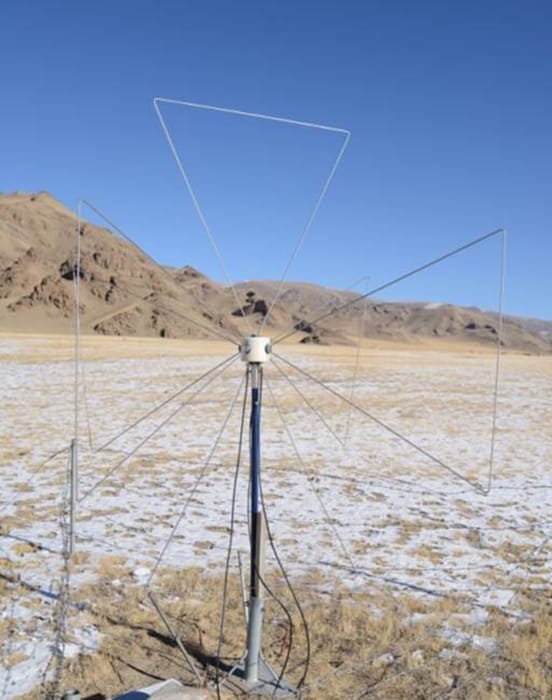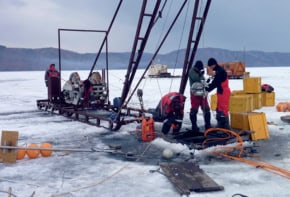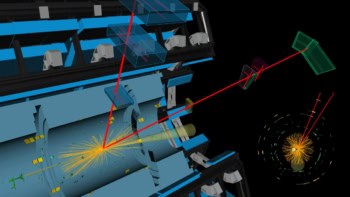
A novel radio telescope, currently being designed by scientists in France, China and other countries, could shed light on some of the most violent cosmic phenomena in the universe. If built, the so-called Giant Radio Array for Neutrino Detection (GRAND) – comprising hundreds of thousands of antennas spread over an area just slightly smaller than the UK – would detect extremely high-energy neutrinos originating from deep space. According to the researchers, GRAND would be considerably cheaper to build than rival telescopes based on optical technology.
As neutrinos interact so weakly with other matter and can cross the universe unimpeded, they can provide valuable information about the phenomena via which they were born. Unfortunately, as they are so elusive, huge detectors are needed to detect any neutrinos on a reasonable timescale.
Radio array
The current leading facility, the $275m IceCube detector, uses thousands of photomultiplier tubes suspended deep within the ice at the South Pole. However, the high cost of photomultiplier tubes limits the overall volume of such a detector, thereby setting an upper limit on the energy of neutrinos that can be snared – especially because the most energetic ones are also the rarest. IceCube has bagged about 100 deep-space neutrinos since turning on in 2011 and looks set to capture several hundred more over the next decade, but is unlikely to detect any having an energy much above 1015 eV.
Rather than detecting light, GRAND will pick up radio signals – because radio antennas are cheaper to make than their optical equivalents, a much larger detector can be built. The scheme relies on tau neutrinos interacting with nuclei as they travel up through the Earth, thereby generating tau leptons that produce showers of secondary particles as they decay in the atmosphere. The synchrotron radiation given off by charged particle showers would be detected by the antennas.
Olivier Martineau-Huynh at the National Institute of Nuclear and Particle Physics (IN2P3) in Paris, together with colleagues worldwide, has developed a basic plan for the detector. GRAND calls for one antenna per square kilometre, over an area of roughly 200,000 km2. Each “detection unit” would consist of three perpendicular butterfly-shaped antenna (pictured) connected to a GPS unit that would time and plot the trajectories of incoming neutrinos. Antennas would be on or around mountains, which would make good sites to pick up the resulting radio waves, as well as being additional targets for incoming neutrinos.
The researchers say that their set-up would be sensitive to neutrinos with energies up to about 1020 eV. Its design is such that about 100 ”cosmogenic” neutrinos – those generated by cosmic rays as they interact with the cosmic microwave background on their journey to Earth and which, having an energy of about 1017 eV, are probably out of IceCube’s reach – should be detected yearly.
According to Martineau-Huynh, GRAND’s observations should help to resolve long-standing questions about the nature and composition of high-energy cosmic rays, and exactly which energetic processes produce them. He says that thanks to an expected very high angular resolution, GRAND could also produce a sky map of astrophysical sources emitting very energetic neutrinos. “It will be the ultimate detector for neutrinos at high energies,” he says.
Cheap challenges
Before they can go any further, however, Martineau-Huynh and co-workers must show that they can indeed make the antennas cheaply. Their estimated price tag for GRAND is $100m (excluding the costs of the manpower involved), so each antenna must be built for no more than $500 – although Martineau-Huynh emphasizes that this is a very preliminary figure. He believes that mass production can push the costs right down, and hopes that one potentially thorny issue – how to transmit antenna data back to base – can be done using cheap Wi-fi technology already employed to monitor oil pipelines.
Another major challenge will be screening out background interference. The researchers calculate that for every cosmic neutrino it detects, GRAND could register as many as a billion events generated by terrestrial sources – such as commercial radio transmissions or thunderstorms. To accurately distinguish their signal from the noise, the researchers are building a prototype array of 35 antennas in the Tian Shan mountains in north-west China. With results from the prototype array expected in 2018, and assuming funding can be obtained from China and other countries, Martineau-Huynh hopes that GRAND might switch on in 2022.
IceCube’s principal investigator, Francis Halzen, of the University of Wisconsin-Madison in the US, describes GRAND’s radio-based approach as “powerful”, but points out that it would not be sensitive to neutrinos with an energy below about 1016 eV because such particles wouldn’t generate detectable radio waves. He also notes that IceCube’s continued non-detection of cosmogenic neutrinos is unfortunately “restricting the number of events an experiment like GRAND can detect in the future”.
A report on GRAND was presented at the 34th International Cosmic Ray Conference, held in the Netherlands earlier this month. A preprint is available on the arXiv server.




